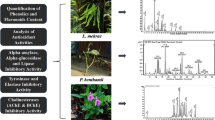Abstract
A series of some 3-,6-,7-,9-,12- monohydroxy tetradecanoic acids were evaluated for their antiurease, antielastase and antioxidant activities for the first time in this study. All the test compounds exhibited antioxidant, antielastase and antiurease activities. The relationship between the position of the hydroxy group and the enzyme inhibition effect is studied in this work. The mentioned biological activities are depending on the position of hydroxy group of tetradecanoic acid isomers. The results obtained in this work are indicating that 3-,6-,7-,9-,12-monohydroxy tetradecanoic acid isomers can be used in agriculture, pharmacy and cosmetic industries due to their excellent antielastase, antiurease and antioxidant activities.

Similar content being viewed by others
References
Ramono, J., & Walter, V. (2009). Food Chemistry, 114, 1122–1129.
Brieskorn, C. H., & Kabelitz, L. (1971). Phytochemistry, 10, 3195–3204.
Markley, K. (1947). Fatty Acids, l, 69.
Çelik, H. (2002). Journal of the Serbian Chemical Society, 67(7), 473–480.
Tolnai, S., & Morgan, J. F. (1962). Canadian Journal of Biochemistry and Physiology, 40, 1367–1373.
Townsend, G. F., Brown, W. H., Felauer, E. E., & Hazlett, B. (1961). Canadian Journal of Biochemistry and Physiology, 39, 1765–1770.
Hayashi, Y., Nishikawa, Y., Mori, H., Tamura, H., Matsushita, Y. I., & Matsui, T. (1998). Journal of Fermentation and Bioengineering, 86, 149–153.
Keinanen, M. M., Korhonen, L. K., Martikainen, P. J., Vartiainen, T., Miettinen, I. T., Lehtola, M. J., Nenonen, K., & Pajunen, H. (2003). Journal of Chromatography B, 783, 443–451.
Larsson, L. (1994). APMIS, 102(3), 161–169.
Broberg, A. (2003). Applied and Environmental Microbiology, 69(12), 7554–7557.
Ferrando, R., Szponar, B., Sánchez, A., Larsson, L., & Valero-Guillén, P. L. (2005). Journal of Microbiological Methods, 62, 285–291.
Jones, P. M., & Bennett, M. J. (2011). Biochimica et Biophysica Acta, 1811, 657–662.
Clayton, P. T., Eaton, S., Aynsley-Green, A., Edginton, M., Hussain, K., Krywawych, S., Datta, V., Malingré, H. E. M., Berger, R., & van den Berg, I. E. T. (2001). The. Journal of Clinical Investigation, 108(3), 457–465.
Khan, K. M., Wadood, A., Ali, M., Zia-Ullah, U.-H., Lodhi, M. A., Khan, M., & Perveen, S. (2010). Journal of Molecular Graphics and Modelling, 28, 792–798.
Mobley, H. L. T., & Hausinger, R. P. (1989). Microbiology Reviews, 53, 85–108.
Zonia, L. E., Stebbin, N. E., & Polacco, J. C. (1995). Plant Physiology, 107, 1097–1103.
Onodo, Y., Takido, M., Magaribuchi, T., & Iwasaki, H. (1990). Japanese Journal of Pharmacology, 52, 631–638.
Lee, K. K., Kim, J. H., Cho, J. J., & Choi, J. D. (1999). International Journal of Cosmetic Science, 21, 71–82.
Robert, L. (2001). Cosmet and Toiletries, 116, 61–70.
Xu, G. H., Ryoo, I. J., Kim, Y. H., Cjoo, S. J., & Yoo, I. D. (2009). Archives of Pharmacal Research, 32, 275–282.
Moon, J.-Y., Yim, E.-Y., Song, G., Lee, N. H., & Hyun, C.-G. (2010). EurAsian Journal of BioSciences, 4, 41–53.
Halliwell, B. (1996). Annual Review of Nutrition, 16, 33–50.
Ng, L. T., Ko, H. H., & Lu, T. M. (2009). Bioorganic & Medicinal Chemistry, 17, 4360–4366.
Hussain, H. H., Babic, G., Durst, T., Wriht, J., Flueraru, M., Chichirau, A., & Chepelev, L. L. (2003). The Journal of Organic Chemistry, 68, 7023–7032.
Grice, H. P. (1988). Food and Chemical Toxicology, 26, 717–723.
Hasdemir, B., & Yusufoğlu, A. (2004). Tetrahedron-Asymmetry, 15, 65–68.
Yanardağ, R., & Bapçum, A. (1996). Chimica Acta Turcica, 24, 15–22.
Van Slyke, D. D., & Archibald, R. M. (1944). The Journal of Biological Chemistry, 154, 623–642.
James, A. E., Timothy, D. W., & Gordon, L. (1996). Biochemistry, 35, 9090–9096.
Oyaizu, M. (1986). Japanese Journal of Nutrition, 44, 307–315.
Apak, R., Güçlü, K., Ozyürek, M., Karademir, S. E., & Erçağ, E. (2006). International Journal of Food Sciences and Nutrition, 57, 292–304.
Cao, Y., & Zhang, X. (2013). Applied Microbiology and Biotechnology, 97, 3323–3331.
Green, B. A., Yu, R. J., & Van Scott, E. J. (2009). Clinics in Dermatology, 27(5), 495–501.
You, Z. L., Xian, D. M., Zhang, M., Cheng, X. S., & Li, X. F. (2012). Bioorganic & Medicinal Chemistry, 20, 4889–4894.
Von Kreybig, T., Preussmann, R., & Schmidt, W. (1968). Arzneimittel-Forschung, 18(6), 645–657.
Xiao, Z. P., Ma, T. W., Peng, X. C., Zhang, A. H., & Zhu, H. L. (2010). European Journal of Medicinal Chemistry, 45, 5064–6070.
Pastene, E., Troncoso, M., Figueroa, G., Alarcon, J., & Speisky, H. (2009). Journal of Agricultural and Food Chemistry, 57, 416–424.
Amtul, Z., Rahman, A., Siddiqui, R. A., & Choudhary, M. I. (2002). Current Medicinal Chemistry, 9, 1323–1348.
Amtul, Z., Rasheed, M., Choudhary, M. I., Rosanna, S., Khan, K. M., & Rahman, A. (2004). Biochemical and Biophysical Research Communications, 319, 1053–1063.
Lodhi, M. A., Abbasi, M. A., Choudhary, M. I., & Ahmad, V. U. (2007). Natural Product Research, 21, 721–725.
Grice, H. C. (1988). Food and Chemical Toxicology, 26, 717–723.
Wichi, H. P. (1986). Food and Chemical Toxicology, 24, 1127–1130.
Rennert, B., & Melzig, M. F. (2002). Planta Medica, 68, 767–769.
Moroy, G., Bourquet, E., Decarme, M., Sapi, J., Alix, A. J. P., Hornebeck, W., & Lorimier, S. (2011). Biochemical Pharmacology, 81, 626–635.
Tohma, H. S., & Gulcin, I. (2010). International Journal of Food Properties, 13, 657–671.
Meir, S., Kanner, J., Akiri, B., & Hadas, S. P. (1995). Journal of Agricultural and Food Chemistry, 43, 1813–1819.
Sokmen, B. B., Onar, H. Ç., Yusufoglu, A., & Yanardag, R. (2012). Journal of the Serbian Chemical Society, 77(10), 1353–1361.
Author information
Authors and Affiliations
Corresponding author
Rights and permissions
About this article
Cite this article
Sokmen, B.B., Hasdemir, B., Yusufoglu, A. et al. Some Monohydroxy Tetradecanoic Acid Isomers as Novel Urease and Elastase Inhibitors and as New Antioxidants. Appl Biochem Biotechnol 172, 1358–1364 (2014). https://doi.org/10.1007/s12010-013-0595-2
Received:
Accepted:
Published:
Issue Date:
DOI: https://doi.org/10.1007/s12010-013-0595-2




